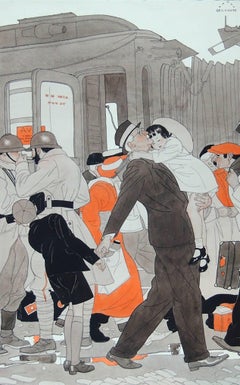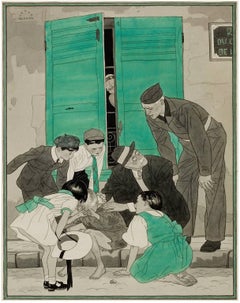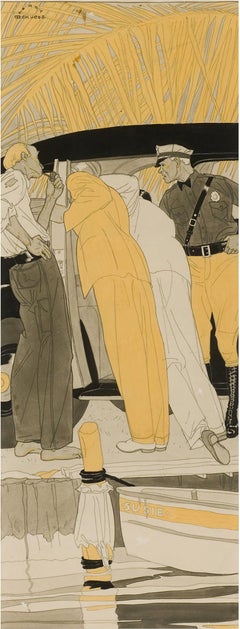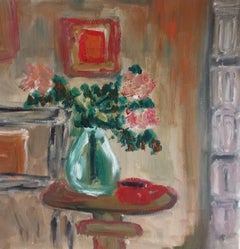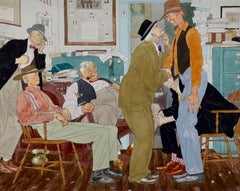Harry Beckhoff Art
to
2
1
Overall Width
to
Overall Height
to
3
1
1
3
2
2
1
1
1
1
1
1
3
3
2
1
1
3
7,738
4,946
2,504
1,373
2
3
Artist: Harry Beckhoff
After the Trip
By Harry Beckhoff
Located in Fort Washington, PA
Medium: Watercolor and Pen and Ink on Paper
Dimensions: 13.75" x 8.88"
Signature: Signed Upper Right
Exhibited:
Masters of the Golden Age: Harvey Dunn and His Students
South Dakota Art Museum, Brookings, South Dakota
May 5, 2015 - September 13, 2015
Norman Rockwell Museum...
Category
Mid-20th Century Harry Beckhoff Art
Materials
Paper, Ink, Watercolor, Pen
Consolation, Collier's magazine illustration
By Harry Beckhoff
Located in Miami, FL
Signed upper left
Category
1940s Academic Harry Beckhoff Art
Materials
Gouache, Paper, Pencil
Searching the Car - Desaturated Colors Muted Warm Yellows and Grey
By Harry Beckhoff
Located in Miami, FL
This Harry Beckhoff illustration is masterfully rendered and intricately designed in line and wash. It's as abstract as it's representational with its graphic style, clean lines, and flat patterning. Every element in the composition works in harmony without a line out of place. The flat and abstract nature of the work rivals that of the great modernist painters of the 1930s.
Perhaps this was done for a major newsstand magazine like Collier's.
Although he studied with Dean Cornwell and Harvey Dunn, he didn't pursue the style of painterly brushstrokes and impastos. Instead, he defined his forms with flat shapes, whose internal forms are defined by thin lines. The emphasis is more on silhouette and line than it is on texture and lighting. Beckhoff also described his work as having been influenced by illustrators like Pierre Brissaud...
Category
1930s Harry Beckhoff Art
Materials
Watercolor, Illustration Board
Related Items
"Morning sunshine, flowers and a cup of coffee" (oil still-life painting )
Located in VÉNISSIEUX, FR
This contemporary painting "Morning sunshine, flowers and a cup of coffee" features a living room, an armchair, a wall with a painting hanging on it, a coffee table with a vase of fl...
Category
2010s Impressionist Harry Beckhoff Art
Materials
Paper, Oil
H 11.82 in W 11.82 in D 0.04 in
Rare Modernist Hungarian Rabbi Pastel Drawing Gouache Painting Judaica Art Deco
By Hugó Scheiber
Located in Surfside, FL
Rabbi in the synagogue at prayer wearing tallit and tefillin.
Hugó Scheiber (born 29 September 1873 in Budapest – died there 7 March 1950) was a Hungarian modernist painter.
Hugo Scheiber was brought from Budapest to Vienna at the age of eight where his father worked as a sign painter for the Prater Theater. At fifteen, he returned with his family to Budapest and began working during the day to help support them and attending painting classes at the School of Design in the evening, where Henrik Papp was one of his teachers. He completed his studies in 1900. His work was at first in a post-Impressionistic style but from 1910 onward showed his increasing interest in German Expressionism and Futurism. This made it of little interest to the conservative Hungarian art establishment.
However, in 1915 he met the great Italian avant-gardist Filippo Tommaso Marinetti and the two painters became close friends. Marinetti invited him to join the Futurist Movement. The uniquely modernist style that he developed was, however, closer to German Expressionism than to Futurism and eventually drifted toward an international art deco manner similar to Erté's. In 1919, he and his friend Béla Kádar held an exhibition at the Hevesy Salon in Vienna. It was a great success and at last caused the Budapest Art Museum to acquire some of Scheiber's drawings. Encouraged, Scheiber came back to live in Vienna in 1920.
A turning point in Scheiber's career came a year later, when Herwarth Walden, founder of Germany's leading avant-garde periodical, Der Sturm, and of the Sturm Gallery in Berlin, became interested in Scheiber's work. Scheiber moved to Berlin in 1922, and his paintings soon appeared regularly in Walden's magazine and elsewhere. Exhibitions of his work followed in London, Rome, La Paz, and New York.
Scheiber's move to Germany coincided with a significant exodus of Hungarian artists to Berlin, including Laszlo Moholy-Nagy and Sandor Bortnyik. There had been a major split in ideology among the Hungarian avant-garde. The Constructivist and leader of the Hungarian avantgarde, Lajos Kassák (painted by Hugó Scheiber in 1930) believed that art should relate to all the needs of contemporary humankind. Thus he refused to compromise the purity of his style to reflect the demands of either the ruling class or socialists and communists. The other camp believed that an artist should be a figurehead for social and political change.
The fall out and factions that resulted from this politicisation resulted in most of the Hungarian avant gardists leaving Vienna for Berlin. Hungarian émigrés made up one of the largest minority groups in the German capital and the influx of their painters had a significant effect on Hungarian and international art. Another turning point of Scheiber's career came in 1926, with the New York exhibition of the Société Anonyme, organized by Katherine Dreier. Scheiber and other important avant garde artists from more than twenty-three countries were represented. In 1933, Scheiber was invited by Marinetti to participate in the great meeting of the Futurists held in Rome in late April 1933, Mostra Nazionale d’Arte Futurista where he was received with great enthusiasm. Gradually, the Hungarian artists began to return home, particularly with the rise of Nazism in Germany. Kádar went back from Berlin in about 1932 and Scheiber followed in 1934.
He was then at the peak of his powers and had a special flair in depicting café and cabaret life in vivid colors, sturdily abstracted forms and spontaneous brush strokes. Scheiber depicted cosmopolitan modern life using stylized shapes and expressive colors. His preferred subjects were cabaret and street scenes, jazz musicians, flappers, and a series of self-portraits (usually with a cigar). his principal media being gouache and oil. He was a member of the prestigious New Society of Artists (KUT—Képzőművészek Új Társasága)and seems to have weathered Hungary's post–World War II transition to state-communism without difficulty. He continued to be well regarded, eventually even receiving the posthumous honor of having one of his images used for a Russian Soviet postage stamp (see image above). Hugó Scheiber died in Budapest in 1950.
Paintings by Hugó Scheiber form part of permanent museum collections in Budapest (Hungarian National Museum), Pecs (Jannus Pannonius Museum), Vienna, New York, Bern and elsewhere. His work has also been shown in many important exhibitions, including:
"The Nell Walden Collection," Kunsthaus Zürich (1945)
"Collection of the Société Anonyme," Yale University Art Gallery, New Haven, Connecticut (1950)
"Hugó Scheiber: A Commemorative Exhibition," Hungarian National Museum, Budapest (1964)
"Ungarische Avantgarde," Galleria del Levante, Munich (1971)
"Paris-Berlin 1900-1930," Centre Georges Pompidou, Paris (1978)
"L’Art en Hongrie, 1905-1920," Musée d’Art et l’Industrie, Saint-Etienne (1980)
"Ungarische Avantgarde in der Weimarer Republik," Marburg (1986)
"Modernizmus," Eresz & Maklary Gallery, Budapest (2006)
"Hugó Scheiber & Béla Kádár," Galerie le Minotaure, Paris and Tel Aviv (2007)
Hugó Scheiber's paintings continue to be regularly sold at Sotheby's, Christie's, Gillen's Arts (London), Papillon Gallery (Los Angeles) and other auction houses.
He was included in the exhibition The Art Of Modern Hungary 1931 and other exhibitions along with Vilmos Novak Aba, Count Julius Batthyany, Pal Bor, Bela Buky, Denes Csanky, Istvan Csok, Bela Czobel, Peter Di Gabor, Bela Ivanyi Grunwald, Baron Ferenc Hatvany, Lipot Herman, Odon Marffy, C. Pal Molnar...
Category
Early 20th Century Modern Harry Beckhoff Art
Materials
Paper, Charcoal, Pastel, Watercolor, Gouache
Gibson Girls - Set of Two 1920's Portraits, Vintage Fashion Illustrations
Located in Soquel, CA
Gorgeous pair of two 1920's watercolor portraits of Gibson girls, one in blue and one in pink, by Charles Hollman (Dutch, 1877-1953). Each portrait renders...
Category
1920s American Impressionist Harry Beckhoff Art
Materials
Watercolor, Paper
Neoclassical composition of a sculptor kneeling before his statue of the Madonna
Located in Middletown, NY
An allegory of loyalty, with the subject's dog pictured seated, holding his master's chisel in his mouth; fidelity personified.
Italian School, 18th century
Ink wash in gray and bl...
Category
Mid-18th Century Italian School Harry Beckhoff Art
Materials
Laid Paper, Ink, Watercolor
Donkey Boogie Woogie, limited color mixed media woman animals
By Jenny Toth
Located in Brooklyn, NY
This is drawing made with pen, pencil and watercolor on wood done from life of donkeys the artist observed in Mexico, and cacti, and a woman holding up the hoof of one donkey. Whims...
Category
2010s Contemporary Harry Beckhoff Art
Materials
Watercolor, Ballpoint Pen, Pencil, Archival Paper
H 16 in W 20 in D 0.5 in
Early 20th Century Young Golfer Figurative
By Margaret Neilson
Located in Soquel, CA
Study of a young man with his golf clubs by listed artist Margaret Neilson Armstrong (American, 1867-1944). Image, 14"H x 20"W. Displayed in vintage mat. S...
Category
1920s Realist Harry Beckhoff Art
Materials
Paper, Pencil
American Contemporary Art by Michael Alan - The Future of Children
By Michael Alan
Located in Paris, IDF
Pen, ink, marker, pencil, watercolor & colored pencils on paper
Michael Alan is an American artist born in 1977 who lives & works in New York, USA. As a multidisciplinary artist. Hi...
Category
2010s Contemporary Harry Beckhoff Art
Materials
Ink, Watercolor, Pen, Permanent Marker, Color Pencil, Paper
H 11 in W 14 in D 0.04 in
Untitled - XXI Century, Gouache Painting, Figurative
By Aleksander Grzybek
Located in Warsaw, PL
ALEKSANDER GRZYBEK He was born in Białystok. He studied artistic education in the studio of painting of prof. Marian Bogusz and Andrzej Kołodziejek. He graduated in 1979. His works c...
Category
Early 2000s Other Art Style Harry Beckhoff Art
Materials
Gouache, Cardboard
Strength in Love
Located in Kansas City, MO
Artist: Ryan Wilks
Title: Strength in Love
Medium: Gold Leaf, Lapis Lazuli, Watercolor, Holy Water, Pen and ink on 243 year old Bible page.
Year: 2019
Dimen...
Category
2010s Contemporary Harry Beckhoff Art
Materials
Gold Leaf
'Mother Nature', Lyrical Surrealist Abstract Watercolour on Paper.
Located in Cotignac, FR
Mid-century lyrical surrealist abstract watercolour on paper by French artist Jean Clerté, signed and dated bottom right. Presented in mid-century frame.
Jean Clerté , born in 1930 in Saint-Savin-sur-Gartempe in Vienne, is a French painter, engraver, draftsman, watercolourist and sculptor . This work is a great example of his more humorous and expressive work influenced by Alechinsky from the late 1960s onwards. There is a light playfulness and yet the watercolours are more vivid than his previous palette.
Jean Clerté works in series. His sequential narrations testify both to a youthful spontaneity and to a perfect mastery in the distribution of forms and images on the painted surface. The narration is not only an accumulation of juxtaposed fragments and symbols, it forms a whole, it takes on and gives meaning. In general, we can say of Clerté that he practices an “eco-art” that feeds on primary hungers: the feeling of being united with nature, the vegetable, the mineral, the aquatic. In his colourful canvases, his inks, his boxes, his objects, like a shaman on the path of his dreams, the painter Clerté mounts an assault on beasts and demons, elves and gnomes. From the Poitevin marshes to the tropical forests emerges a fauna caught in the meanders of a design that marvels at the appearance of these grotesque idols.
Jean Clerté began to draw and paint at a very young age, and at the age of 15 he enrolled at the École des Beaux-Arts in Poitiers. Then in 1949, curious about the capital, he moved to Paris. Having very few financial resources, he could not continue his studies at first, worked as a model to survive, and met other artists; he was then admitted to the studio of Ossip Zadkine and, from 1952, he was also able to study engraving at Atelier 17 of Stanley William Hayter, an English engraver and printer living in Paris associated in the 1930s with surrealism.
At the end of the 1960s, he worked alongside Pierre Alechinsky, founding member of the Cobra movement, engraving Alechinsky's originals, benefiting from his advice, and discovering acrylic as a medium.
From 1976, Jean Clerté became associate professor at Hayter. Clerté had taught previously, in 1971 at the Salzburg Summer University and in 1972 he gave courses at the Paris-Sorbonne University . In 1981, he was appointed professor at the School of Decorative Arts , where he had Maïlys Seydoux-Dumas as a student and, from 1983 to 1988, he was Alechinsky's assistant professor at the Paris School of Fine Arts.
His first works are part of the current of lyrical abstraction, and are nourished by impressions of nature (landscape motifs, e.g. forest fires, waterscapes), then around 1968, encouraged by Alechinsky, he rejects abstraction, and his work becomes more figurative with expressive and humorous elements. From this period his colours are more subdued, often with pastel tones, he works on series. Jean Clerté has created a world in a space where drawing, painting, objects participate in a playful figuration. From his drawings were born sculptures and sometimes mobiles (Le Moulin à dessin). If it is the artist who makes astonishing, polychrome, whimsical “toys”, it is the painter who appeals to adults through his caustic and satirical humour.
His first exhibitions in France took place at the Galerie Massol , then at the Galerie Pascal...
Category
Mid-20th Century Expressionist Harry Beckhoff Art
Materials
Paper, Watercolor
H 22.05 in W 28.75 in D 2.37 in
Ernie Banks at Ebetts Field - Chicago Cubs Baseball Great, Watercolor Framed
By Margie Lawrence
Located in Chicago, IL
Ernie Banks, aka "Mr. Cub" and "Mr. Sunshine", was a professional baseball player who starred in Major League Baseball as a shortstop and first baseman for...
Category
2010s Contemporary Harry Beckhoff Art
Materials
Paper, Watercolor
Yogi and Ted - Baseball Greats Yogi Berra and Ted Williams, Watercolor on Paper
By Margie Lawrence
Located in Chicago, IL
Lawrence Peter "Yogi" Berra was an American professional baseball catcher who later took on the roles of manager and coach. He played 19 seasons in Ma...
Category
2010s Contemporary Harry Beckhoff Art
Materials
Watercolor, Paper
Previously Available Items
Men in Newspaper Office
By Harry Beckhoff
Located in Fort Washington, PA
Medium: Ink and Watercolor on Paper
Signature: Signed Lower Right
Category
Mid-20th Century Harry Beckhoff Art
Materials
Paper, Ink, Watercolor
Harry Beckhoff art for sale on 1stDibs.
Find a wide variety of authentic Harry Beckhoff art available for sale on 1stDibs. You can also browse by medium to find art by Harry Beckhoff in paint, watercolor, ink and more. Not every interior allows for large Harry Beckhoff art, so small editions measuring 7 inches across are available. Customers who are interested in this artist might also find the work of Edmund Darch Lewis, Emile Godchaux, and Ferdinand Victor Leon Roybet . Harry Beckhoff art prices can differ depending upon medium, time period and other attributes. On 1stDibs, the price for these items starts at $2,750 and tops out at $12,000, while the average work can sell for $2,900.
